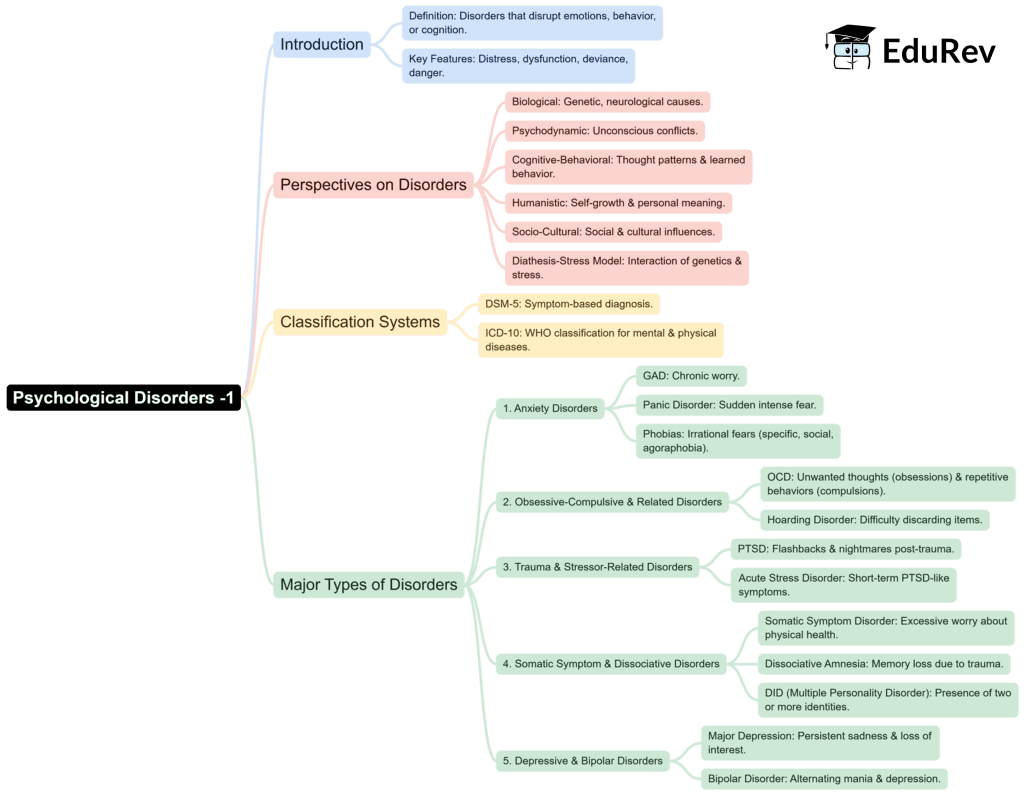Humanities/Arts Exam > Humanities/Arts Notes > Psychology Class 12 > Mind Map: Psychological Disorders - 1
Mind Map: Psychological Disorders - 1 | Psychology Class 12 - Humanities/Arts PDF Download

The document Mind Map: Psychological Disorders - 1 | Psychology Class 12 - Humanities/Arts is a part of the Humanities/Arts Course Psychology Class 12.
All you need of Humanities/Arts at this link: Humanities/Arts
|
25 videos|97 docs|24 tests
|
FAQs on Mind Map: Psychological Disorders - 1 - Psychology Class 12 - Humanities/Arts
| 1. What are the most common psychological disorders? |  |
Ans. The most common psychological disorders include anxiety disorders (such as generalized anxiety disorder and panic disorder), mood disorders (like depression and bipolar disorder), personality disorders (such as borderline personality disorder), and psychotic disorders (including schizophrenia). These disorders affect millions of people and can significantly impact daily functioning.
| 2. How can psychological disorders be treated? |  |
Ans. Psychological disorders can be treated through a combination of therapy, medication, and lifestyle changes. Common therapeutic approaches include cognitive-behavioral therapy (CBT), psychotherapy, and support groups. Medications, such as antidepressants or antipsychotics, may also be prescribed to help manage symptoms. Lifestyle changes like regular exercise, a balanced diet, and mindfulness practices can further enhance treatment outcomes.
| 3. What are the symptoms of anxiety disorders? |  |
Ans. Symptoms of anxiety disorders can vary but often include excessive worry, restlessness, difficulty concentrating, irritability, muscle tension, and sleep disturbances. Physical symptoms may also occur, such as rapid heartbeat, sweating, trembling, or gastrointestinal issues. It's important to recognize these symptoms early for effective management.
| 4. How do psychological disorders affect daily life? |  |
Ans. Psychological disorders can greatly affect daily life by impairing an individual's ability to function at work, maintain relationships, and perform routine activities. Symptoms may lead to social withdrawal, decreased productivity, and difficulties in managing stress. The impact on mental and emotional well-being can also result in lower quality of life.
| 5. What is the difference between a psychologist and a psychiatrist? |  |
Ans. The primary difference between a psychologist and a psychiatrist is their training and approach to treatment. Psychologists typically hold a doctoral degree in psychology and focus on therapy and counseling, often using behavioral and cognitive approaches. Psychiatrists, on the other hand, are medical doctors who can prescribe medication and often take a more biological approach to treatment, addressing the chemical imbalances associated with psychological disorders.
Related Searches





















